
Darlingtonia californica, also called the California pitcher plant, cobra lily, or cobra plant, is a species of carnivorous plant. As a pitcher plant it is the sole member of the genus Darlingtonia in the family Sarraceniaceae. It is native to Northern California and Oregon growing in bogs and seeps with cold running water. This plant is designated as uncommon due to its rarity in the field.

Arisaema is a large and diverse genus of the flowering plant family Araceae. The largest concentration of species is in China and Japan, with other species native to other parts of southern Asia as well as eastern and central Africa, Mexico and eastern North America. Asiatic species are often called cobra lilies, while western species are often called jack-in-the-pulpit; both names refer to the distinctive appearance of the flower, which consists of an erect central spadix rising from a spathe.
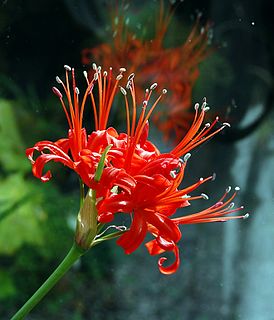
Nerine sarniensis, commonly known as Guernsey lily or Jersey lily, is a species of flowering plant in the family Amaryllidaceae. It is the type species of the Nerine genus. It is widely cultivated in the temperate world and is particularly associated with the island of Guernsey, as reflected in both its Latin and common names, though it does not originate there, nor is it a true lily. It is native to the Northern and Western Cape Provinces of South Africa, though it is now naturalized in France, Madeira and the Azores.

Arisaema triphyllum is a herbaceous perennial plant growing from a corm. It is a highly variable species typically growing 30–65 centimetres (12–26 in) in height with three-parted leaves and flowers contained in a spadix that is covered by a hood. It is native to eastern North America, occurring in moist woodlands and thickets from Nova Scotia west to Minnesota, and south to southern Florida and Texas.

Arum is a genus of flowering plants in the family Araceae, native to Europe, northern Africa, and western and central Asia, with the highest species diversity in the Mediterranean region. Frequently called arum lilies, they are not closely related to the true lilies Lilium. Plants in closely related Zantedeschia are also called "arum lilies".
Cobra lily is the common name of several plants, none of which are members of the lily family. The name derives from the resemblance of the flower to the hood of a cobra.
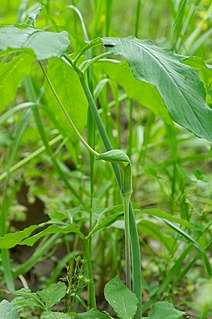
Arisaema dracontium, the dragon-root or green dragon, is a herbaceous perennial plant in the genus Arisaema and the family Araceae. It is native to North America from Quebec through Minnesota south through Florida and Texas, where it is found growing in damp woods. It has also been reported from northeastern Mexico Plants grow 20–50 centimetres (7.9–19.7 in) tall when in bloom and after flowering reach 100 centimetres (39 in), and each grows from a corm. Normally, a plant produces one leaf with a long petioles, its leaf is composed of 7 to 13 leaflets, with its central leaflet being the largest one and with leaflets becoming smaller as they are produced distally, the leaflets are held out horizontally over the plant. During flowering in spring, a single slender, green spathe 3–6 centimetres (1.2–2.4 in) long is produced; it covers a tapering, long thin spadix. The tail-like spadix grows out around the top of its spathe. After flowering, up to 150 berries are produced in a club-shaped column. In late summer, the green berries turn orange-red, each berry produces 1 to 3 seeds. It is listed as a vulnerable species in Canada.

Agapanthus praecox is a popular garden plant around the world, especially in Mediterranean climates. It is native of Natal and Cape of Good Hope in South Africa, local names include agapant, bloulelie, isicakathi and ubani. Most of the cultivated plants of the genus Agapanthus are hybrids or cultivars of this species. It is divided into three subspecies: subsp.praecox, subsp. orientalis and subsp. minimus.
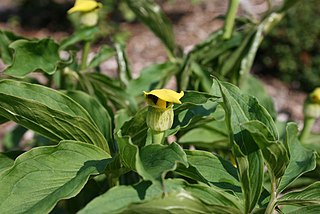
Arisaema flavum is a species of flowering plant widespread across north-eastern Africa and southern Asia. It is native to Ethiopia, Somalia, the Arabian Peninsula, Pakistan, Afghanistan, Nepal, Assam, Himalayas, Tibet, Yunnan, and Sichuan. The species epithet flavum is Latin for yellow and indicates its flower colour.
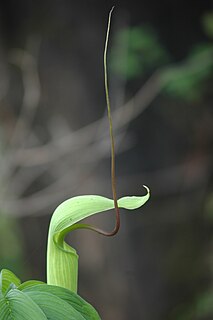
Arisaema tortuosum, the whipcord cobra lily, is a plant species in the family Araceae. It has a distinctive purple or green whip-like spadix which arises from the mouth of its "jack-in the-pulpit" flower and may be up to 30 cm long. Flowers may be male or bisexual. The clustered fruits are green at first, ripening to red. The plant grows in large clumps and can be up to 2 metres in height.

Dianella revoluta, commonly known as blueberry lily, blue flax-lily, or black-anther flax-lily, a species of flowering plant in the family Asphodelaceae and is endemic to, and widespread in Australia. It is a tufted, perennial herb with grass-like leaves and up to nine blue or violet flowers with six tepals, and stamens with bright yellow filaments and pale brown to almost black anthers.

Lilium wallichianum is an Asian species of bulbous plants in the lily family native to the Indian Subcontinent and to Myanmar. It is native to India, as well as Nepal, Bhutan, and Myanmar.

Arisaema candidissimum is a species of flowering plant in the arum family (Araceae), originating in western China. Various English names have been given to the species, including Chinese cobra lily and Chinese jack-in-the-pulpit. The Chinese name is 白苞南星.
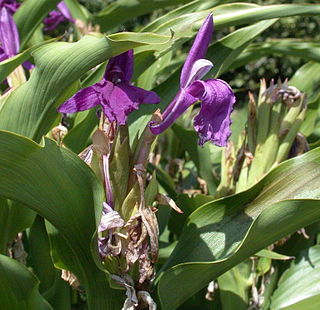
Roscoea auriculata is a perennial herbaceous plant occurring in the eastern Himalayas, in Tibet, Bhutan, Nepal and Sikkim. Most members of the ginger family (Zingiberaceae), to which it belongs, are tropical, but R. auriculata, like other species of Roscoea, grows in much colder mountainous regions. It is sometimes grown as an ornamental plant in gardens.

Roscoea cautleyoides is a perennial herbaceous plant occurring in the Sichuan and Yunnan provinces of China. The scientific name is also spelt Roscoea cautleoides. Most members of the ginger family (Zingiberaceae), to which it belongs, are tropical, but R. cautleyoides, like other species of Roscoea, grows in much colder mountainous regions. It is sometimes grown as an ornamental plant in gardens.
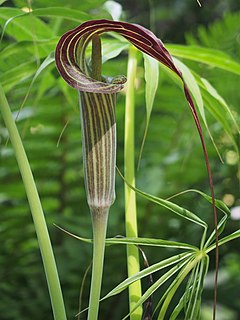
Arisaema erubescens is a flowering plant species in the genus Arisaema, endemic to Nepal.
Iris subg. Nepalensis is one subgenus of Iris, also known as 'Himalayan irises'. It was formerly genus Junopsis.
Iris sikkimensis is a plant species in the genus Iris, it is also in the subgenus Iris and in the section Pseudoregelia. It is a rhizomatous perennial, from Sikkim. It has pale green or light green thin leaves, slender stem, 2 or 3 lilac or purple flowers, with a white beard with orange tips. It is thought to be a hybrid of Iris hookeriana and Iris kumaonensis.
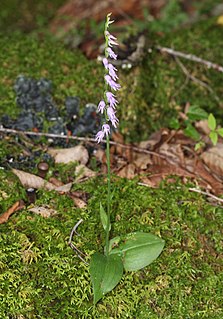
Ponerorchis cucullata, formerly Neottianthe cucullata, is a species of flowering plant in the family Orchidaceae, native to temperate Eurasia from Poland to Japan, and also to the Himalayas. It is terrestrial, growing from tubers, to a height of up to 30 cm, with pinkish flowers arranged in a one-sided spike. It was placed in several different genera before a study in 2014 showed that it belonged in an expanded Ponerorchis.

Mimetes stokoei, the mace pagoda, is an evergreen, upright, hardly branching, large shrub of 1–2 m high in the family Proteaceae. It has silvery, oval leaves of 5–8 cm (2.0–3.2 in) long and 2 1⁄2–4 cm (1.0–1.6 in) wide, with one large tooth supported by two smaller teeth near the tip, at an upward angle and somewhat overlapping each other. The inflorescences are set just below the growing tip, are cylinder-shaped, 10–12 cm (4–5 in) high, topped by a crest of small, more or less horizontal, pinkish-purple tinged leaves. It consists of several flower heads in the axils of golden leaves with a pinkish wash that form a hood shielding the underlying flower head. Each flower head contains eight to twelve individual flowers, with amber-colored styles topped by blackish purple pollen presenters and grey silky perianth lobes. It is endemic to the Fynbos ecoregion of South Africa, being confined to the Kogelberg mountain range. The mace pagoda was twice presumed extinct, but reappeared in its natural habitat from seed, after a wildfire several decades later.

















